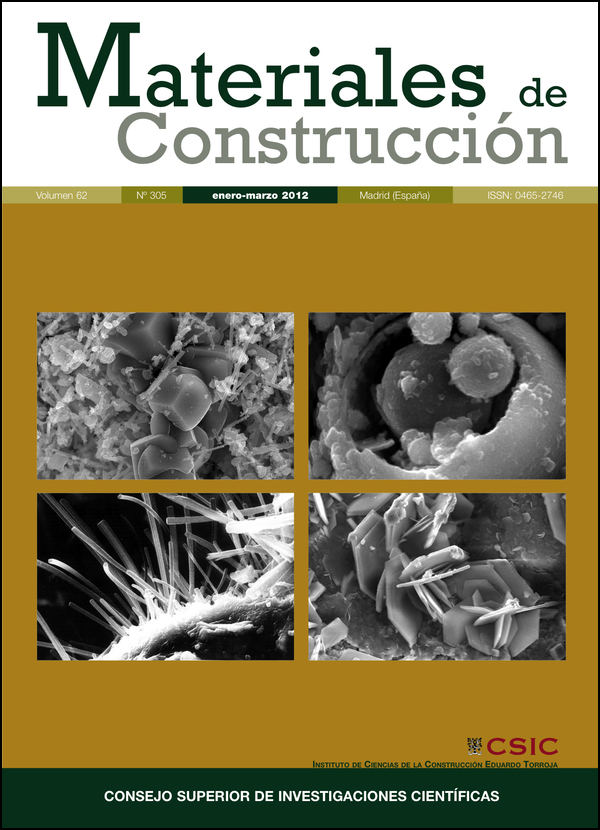Dependence of ultrasonic pulse propagation velocity on free water content in concrete structure under tropical climate conditions
DOI:
https://doi.org/10.3989/mc.2011.60910Keywords:
ultrasonic pulse velocity, water content, concrete, modelingAbstract
One of the fundamental applications of the ultrasonic pulse velocity method (UPV) to the study of concrete consists in the estimation of the mechanical properties. The precision on the estimation of theses properties may be dependent on the incidence of several factors, one of them is the free water content absorbed by the sample of concrete under working conditions. In this paper it is shown that the modeling of the dependence between the ultrasonic pulse velocity and the content of free water in the hardened concrete requires the non linear approach. We propose two models, one of them being a non linear mathematical model fitting the experimental data points, and the other of them being a simple physical model structured by considering the concrete material as composed as heterogeneous medium. Besides, it is discussed under which condition the linear approach for modelling proposed by other authors can be used.
Downloads
References
1. Rio, L.M.; Jimenez, A.; Lopez, F.; Rufo, M. M.; Paniagua, J.M : “Characterization and hardening of concrete with ultrasonic testing” Ultrasonics, Volume 42, Issues 1-9 April (2004), pages 527-530, Proceedings of Ultrasonics International 2003.
2. Gozde Ozerkan, N.; Yaman Ozgur, I.: “ Evaluation of cement mortars by ultrasound”. 4th Middle East NDT Conference and Exhibitions, Kingdom of Baharain, 2007.
3. Del Rio L.M, Lopez F., Pareja C., Callejas B. “An ultrasound study of concrete hardening in construction pillars” 19 th International Congress on Acoustics, Madrid, September 2007
4. Malhotra, V.M.; Carino, N.J. “CRC handbook on Non Destructive testing of concrete” N.J CRC Press, Boca Raton Florida, (1991).
5. Sandor, P. “The behavior of ultrasonic pulse in concrete” Cement and Concrete Research. Vol 20.Issues 2, March (1990), pages 259-270
6. Rodríguez, M. “Influencia de la humedad del concreto sobre el valor de la velocidad del pulso ultrasónico” Cemento –Hormigón. España. Marzo (1999). No 795, pag. 243
7. Etsuzo Ohdaira, Nobuyoshi Masuzawa. “Water content and effect on ultrasound propagation in concrete – the possibility of NDE”, Ultrasonics, Volume 38, Issues1-8, March (2000), pages 546-552
8. Zhou D. Xiaozhou, L.; Xiufen, G. “Water content diagnostic of concrete using Non linear acoustic means”. 17th World Conference on Non Destructive Testing Octuber 2008, Shangai, China.
9. Martys, N. S. “Survey of Concrete Transport Properties and Their Measu rement”. US Department of Commerce Technology Administration National Institute of Standards and Technology, Glthersburg MD 20899, February (1995).
10. Rafik, B.; Menghao.; Q, Abdelkarin, A.M. “Modeling of transport in Porous building materials by gravimetric sorption-desorption tests”. Annex 41, Moist-Eng, working meeting, April 3-5, (2006), Kyoto, Japan.
11. Qin, S.C.; Chen, D.; Wang; H. “ Simultaneous heat and moisture transfer in concrete with time-dependent boundary conditions” Magazine of Concrete Research, (2008), 60 No.10 December 725-733. http://dx.doi.org/10.1680/macr.2008.00021
12. Wonlwosen Ali, B.S.C.E. “Finite Element temperature development and moisture diffusion prediction models for concrete at early ages using Matlab”A Thesis in Civil Engineering, Master of science in Civil Engineering. Texas Tech University, (2010).
13. Mukhopadhyay, A. K .; Ye, D.; Zollinger, D. “Moisture –Related Cracking effects on Hydratating concrete pavement” Texas Transportation Institute, Report 0-1700-6, Project 0-1700. (2006)
14. Fadragas, C. R.; Rodriguez, M.; Bonal, R. “Modelling the propagation of a ultrasonic ray through a heterogeneous medium”, NDT.net, Vol. 8, No.11,(2003).
Downloads
Published
How to Cite
Issue
Section
License
Copyright (c) 2012 Consejo Superior de Investigaciones Científicas (CSIC)

This work is licensed under a Creative Commons Attribution 4.0 International License.
© CSIC. Manuscripts published in both the print and online versions of this journal are the property of the Consejo Superior de Investigaciones Científicas, and quoting this source is a requirement for any partial or full reproduction.
All contents of this electronic edition, except where otherwise noted, are distributed under a Creative Commons Attribution 4.0 International (CC BY 4.0) licence. You may read the basic information and the legal text of the licence. The indication of the CC BY 4.0 licence must be expressly stated in this way when necessary.
Self-archiving in repositories, personal webpages or similar, of any version other than the final version of the work produced by the publisher, is not allowed.
















